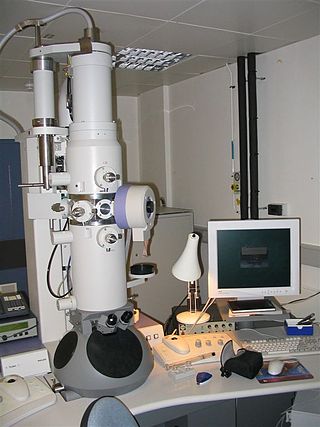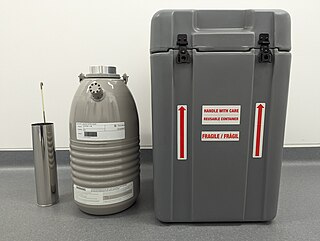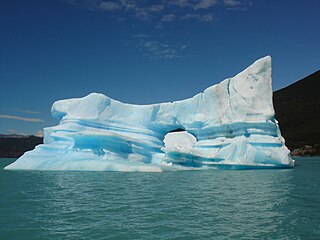Related Research Articles

An electron microscope is a microscope that uses a beam of electrons as a source of illumination. They use electron optics that are analogous to the glass lenses of an optical light microscope to control the electron beam, for instance focusing them to produce magnified images or electron diffraction patterns. As the wavelength of an electron can be up to 100,000 times smaller than that of visible light, electron microscopes have a much higher resolution of about 0.1 nm, which compares to about 200 nm for light microscopes. Electron microscope may refer to:

A scanning electron microscope (SEM) is a type of electron microscope that produces images of a sample by scanning the surface with a focused beam of electrons. The electrons interact with atoms in the sample, producing various signals that contain information about the surface topography and composition of the sample. The electron beam is scanned in a raster scan pattern, and the position of the beam is combined with the intensity of the detected signal to produce an image. In the most common SEM mode, secondary electrons emitted by atoms excited by the electron beam are detected using a secondary electron detector. The number of secondary electrons that can be detected, and thus the signal intensity, depends, among other things, on specimen topography. Some SEMs can achieve resolutions better than 1 nanometer.

Ethane is a naturally occurring organic chemical compound with chemical formula C
2H
6. At standard temperature and pressure, ethane is a colorless, odorless gas. Like many hydrocarbons, ethane is isolated on an industrial scale from natural gas and as a petrochemical by-product of petroleum refining. Its chief use is as feedstock for ethylene production.
Cryobiology is the branch of biology that studies the effects of low temperatures on living things within Earth's cryosphere or in science. The word cryobiology is derived from the Greek words κρῧος [kryos], "cold", βίος [bios], "life", and λόγος [logos], "word". In practice, cryobiology is the study of biological material or systems at temperatures below normal. Materials or systems studied may include proteins, cells, tissues, organs, or whole organisms. Temperatures may range from moderately hypothermic conditions to cryogenic temperatures.

Vitrification is the full or partial transformation of a substance into a glass, that is to say, a non-crystalline amorphous solid. Glasses differ from liquids structurally and glasses possess a higher degree of connectivity with the same Hausdorff dimensionality of bonds as crystals: dimH = 3. In the production of ceramics, vitrification is responsible for their impermeability to water.

Liquid nitrogen—LN2—is nitrogen in a liquid state at low temperature. Liquid nitrogen has a boiling point of about −195.8 °C (−320 °F; 77 K). It is produced industrially by fractional distillation of liquid air. It is a colorless, mobile liquid whose viscosity is about one tenth that of acetone. Liquid nitrogen is widely used as a coolant.

A scanning transmission electron microscope (STEM) is a type of transmission electron microscope (TEM). Pronunciation is [stɛm] or [ɛsti:i:ɛm]. As with a conventional transmission electron microscope (CTEM), images are formed by electrons passing through a sufficiently thin specimen. However, unlike CTEM, in STEM the electron beam is focused to a fine spot which is then scanned over the sample in a raster illumination system constructed so that the sample is illuminated at each point with the beam parallel to the optical axis. The rastering of the beam across the sample makes STEM suitable for analytical techniques such as Z-contrast annular dark-field imaging, and spectroscopic mapping by energy dispersive X-ray (EDX) spectroscopy, or electron energy loss spectroscopy (EELS). These signals can be obtained simultaneously, allowing direct correlation of images and spectroscopic data.

Transmission electron cryomicroscopy (CryoTEM), commonly known as cryo-EM, is a form of cryogenic electron microscopy, more specifically a type of transmission electron microscopy (TEM) where the sample is studied at cryogenic temperatures. Cryo-EM, specifically 3-dimensional electron microscopy (3DEM), is gaining popularity in structural biology.

Cryo-electron tomography (cryo-ET) is an imaging technique used to produce high-resolution (~1–4 nm) three-dimensional views of samples, often biological macromolecules and cells. cryo-ET is a specialized application of transmission electron cryomicroscopy (CryoTEM) in which samples are imaged as they are tilted, resulting in a series of 2D images that can be combined to produce a 3D reconstruction, similar to a CT scan of the human body. In contrast to other electron tomography techniques, samples are imaged under cryogenic conditions. For cellular material, the structure is immobilized in non-crystalline, vitreous ice, allowing them to be imaged without dehydration or chemical fixation, which would otherwise disrupt or distort biological structures.

A cooling bath or ice bath, in laboratory chemistry practice, is a liquid mixture which is used to maintain low temperatures, typically between 13 °C and −196 °C. These low temperatures are used to collect liquids after distillation, to remove solvents using a rotary evaporator, or to perform a chemical reaction below room temperature.

Cryopreservation or cryoconservation is a process where biological material - cells, tissues, or organs - are frozen to preserve the material for an extended period of time. At low temperatures any cell metabolism which might cause damage to the biological material in question is effectively stopped. Cryopreservation is an effective way to transport biological samples over long distances, store samples for prolonged periods of time, and create a bank of samples for users. Molecules, referred to as cryoprotective agents (CPAs), are added to reduce the osmotic shock and physical stresses cells undergo in the freezing process. Some cryoprotective agents used in research are inspired by plants and animals in nature that have unique cold tolerance to survive harsh winters, including: trees, wood frogs, and tardigrades.
A cryopreservation straw is a small storage device used for the cryogenic storage of liquid samples, often in a biobank or other collection of samples. Their most common application is for storage of sperm for in-vitro fertilization.
Scanning electron cryomicroscopy (CryoSEM) is a form of electron microscopy where a hydrated but cryogenically fixed sample is imaged on a scanning electron microscope's cold stage in a cryogenic chamber. The cooling is usually achieved with liquid nitrogen. CryoSEM of biological samples with a high moisture content can be done faster with fewer sample preparation steps than conventional SEM. In addition, the dehydration processes needed to prepare a biological sample for a conventional SEM chamber create numerous distortions in the tissue leading to structural artifacts during imaging.

Jacques Dubochet is a retired Swiss biophysicist. He is a former researcher at the European Molecular Biology Laboratory in Heidelberg, Germany, and an honorary professor of biophysics at the University of Lausanne in Switzerland.

Cryogenic electron microscopy (cryo-EM) is a cryomicroscopy technique applied on samples cooled to cryogenic temperatures. For biological specimens, the structure is preserved by embedding in an environment of vitreous ice. An aqueous sample solution is applied to a grid-mesh and plunge-frozen in liquid ethane or a mixture of liquid ethane and propane. While development of the technique began in the 1970s, recent advances in detector technology and software algorithms have allowed for the determination of biomolecular structures at near-atomic resolution. This has attracted wide attention to the approach as an alternative to X-ray crystallography or NMR spectroscopy for macromolecular structure determination without the need for crystallization.

Cell unroofing is any of various methods to isolate and expose the cell membrane of cells. Differently from the more common membrane extraction protocols performed with multiple steps of centrifugation, in cell unroofing the aim is to tear and preserve patches of the plasma membrane in order to perform in situ experiments using.
Robert Martin Glaeser is an American biochemist. He is a professor emeritus of Biochemistry, Biophysics and Structural Biology at the University of California, Berkeley and a faculty scientist at Lawrence Berkeley National Laboratory, in Berkeley, California, US. His main research area is electron diffraction and membrane models.
Cryomicroscopy is a technique in which a microscope is equipped in such a fashion that the object intended to be inspected can be cooled to below room temperature. Technically, cryomicroscopy implies compatibility between a cryostat and a microscope. Most cryostats make use of a cryogenic fluid such as liquid helium or liquid nitrogen. There exists two common motivations for performing a cryomicroscopy. One is to improve upon the process of performing a standard microscopy. Cryogenic electron microscopy, for example, enables the studying of proteins with limited radiation damage. In this case, the protein structure may not change with temperature, but the cryogenic environment enables the improvement of the electron microscopy process. Another motivation for performing a cryomicroscopy is to apply the microscopy to a low-temperature phenomenon. A scanning tunnelling microscopy under a cryogenic environment, for example, allows for the studying of superconductivity, which does not exist at room temperature.

A dry shipper, or cryoshipper, is a container specifically engineered to transport biological specimens at cryogenic temperatures utilizing the vapor phase of liquid nitrogen.

Freeze-fracture is a natural occurrence leading to processes like erosion of the earths crust or simply deterioration of food via freeze-thaw cycles.. To investigate the process further freeze-fracture is artificially induced to view in detail the properties of materials. Fracture during freezing is often the result of crystalizing water which results in expansion. Crystallization is also a factor leading to chemical changes of a substance due to changes in the crystal surroundings called eutectic formation.
References
- ↑ Pilhofer, Martin; Ladinsky, Mark S.; McDowall, Alasdair W.; Jensen, Grant J. (2010). Bacterial TEM. Methods in Cell Biology. Vol. 96. pp. 21–45. doi:10.1016/S0091-679X(10)96002-0. ISBN 9780123810076. ISSN 0091-679X. PMID 20869517.
- ↑ Echlin P (1992). Low Temperature Microscopy and Analysis. New York: Plenum Publishing Corporation.
- ↑ Dubochet J, Adrian M, Chang JJ, Homo JC, Lepault J, McDowall AW, Schulz P (1988). "Cryo-electron microscopy of vitrified specimens" (PDF). Quarterly Reviews of Biophysics. 21 (2): 129–228. doi:10.1017/s0033583500004297. PMID 3043536. S2CID 2741633.
- ↑ Battersby BJ, Sharp JC, Webb RI, Barnes GT (1994). "Vitrification of aqueous suspensions from a controlled environment for electron microsocopy: an improved plunge-cooling device". Journal of Microscopy. 176 (2): 110–120. doi:10.1111/j.1365-2818.1994.tb03505.x. S2CID 95926972.
- ↑ Ryan, Keith P. (1992). "Cryofixation of tissues for electron microscopy: a review of plunge cooling methods" (PDF). Scan. Microsc. 6 (3): 715–743.
- ↑ Bald WB (1984). "The relative efficiency of cryogenic fluids used in the rapid quench-cooling of cryogenic samples". Journal of Microscopy. 134 (3): 261–270. doi:10.1111/j.1365-2818.1984.tb02519.x. S2CID 97233738.
- ↑ Allison DP, Daw CS, Rorvik MC (1987). "The construction and operation of a simple and inexpensive slam freezing device for electron microscopy". Journal of Microscopy. 147 (Pt 1): 103–108. doi:10.1111/j.1365-2818.1987.tb02822.x. PMID 3305955. S2CID 112876.
- ↑ Bald WB (1987). Quantitative Cryofixation. Bristol and Philadelphia: Adam Hilger.
- ↑ Leunissen Jan L.M. and Yi H. (2009). "Self-pressurized rapid freezing (SPRF): a novel cryofixation method for specimen preparation in electron microscopy". J. Microsc. 235 (1): 25–35. doi:10.1111/j.1365-2818.2009.03178.x. PMID 19566624. S2CID 205342519. Archived from the original on 2013-01-05.
- ↑ Studer, D (September 1995). "Vitrification of articular cartilage by high-pressure freezing". Journal of Microscopy. 179 (3): 321–322. doi:10.1111/j.1365-2818.1995.tb03648.x. PMID 7473694. S2CID 32347571.
- ↑ Silva, A. C. C.; Schmidt, F. C. (2019-10-01). "Vacuum Freezing of Coffee Extract Under Different Process Conditions". Food and Bioprocess Technology. 12 (10): 1683–1695. doi:10.1007/s11947-019-02314-x. ISSN 1935-5149. S2CID 201644501.